Stabilization of a highly porous metal–organic framework utilizing a carborane-based linker†
Abstract
The first tritopic carborane-based linker, H3BCA (C15B24O6H30), based on closo-1,10-C2B8H10, has been synthesized and incorporated into a metal–organic framework (MOF), NU-700 (Cu3(BCA)2). In contrast to the analogous MOF-143, NU-700 can be activated with retention of porosity, yielding a BET surface area of 1870 m2 g−1.


 Please wait while we load your content...
Please wait while we load your content...